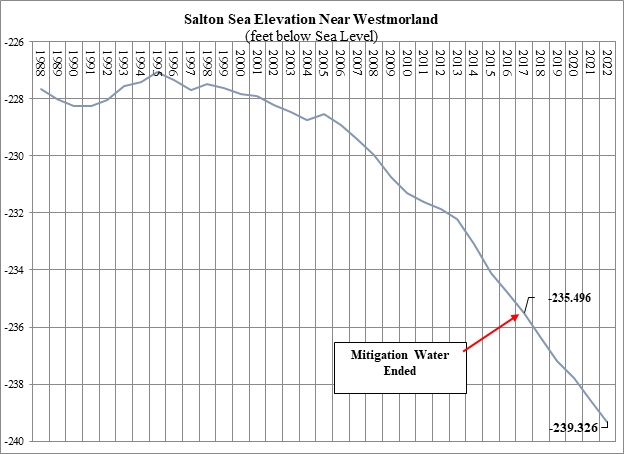Time for Hydrowonk to update the deteriorating status of the Salton Sea.
Over four years ago, a Los Angeles Times Editorial stated: “The Salton Sea is a disaster in the making. California isn’t doing anything about it.”
Last year, the Bureau of Reclamation and the Imperial Irrigation District announced an agreement on the Salton Sea as part of federal action to reduce California’s use of Colorado River water. The $250 million of federal funding was not a good deal for the Salton Sea.
With the continued inaction since 2017, when the Imperial Irrigation District’s obligation to mitigate the impact of its conserved water transfers to the San Diego County Water Authority ended, the facts are clear:
The rapid decline in Salton Sea’s elevation is accelerating
Continued delay will only mean that the dimension of the challenge in five years, ten years or longer into the future will be substantially greater than the challenge today.
What are the dynamics of the Salton Sea’s elevation?
As reported in a previous post, the long-term, sustained decline of the Salton Sea is a conundrum. Under the terms of the historic long-term water conservation and transfer agreement between the Imperial Irrigation District and the San Diego County Water Authority, the impact of the transfer through 2017 was fully mitigated. So, what other forces are at work?
Let’s update the facts about the Salton Sea’s elevation. The chart below shows daily average elevation by year to show how the Salton Sea’s elevation is evolving over time. There are three eras of trends in Salton Sea elevation since 1988 (earliest year for available USGS. data). From 1988 through 1995, there was an increasing trend in Salton Sea elevation of 0.138 feet per year. Thereafter, a declining trend in Salton Sea elevation began. Between 1996 through 2005, there was a decreasing trend in Salton Sea elevation of 0.11 feet per year. The decline in Salton Sea elevation accelerated after 2005 to a rate of 0.45 feet per year through the year 2017. The elevation of the Salton Sea has been in free fall for the past seventeen years. Since the end of the Imperial Irrigation District’s mitigation obligations in 2017, the elevation has fallen from 235.496 feet below sea level to 239.326 feet below sea level by 2022.

The variability of Salton Sea’s elevation around these trends is instructive (see chart). For the USGS historic record 1988-2017, the variability of the actual Salton Sea elevation around trend ranges from a low of -0.45 feet to a high of +0.62 feet. With the end of mitigation water being delivered into the Salton Sea starting in 2018, the deviation below trend declined by 0.808 feet in 2018, 1.054 feet in 2019, 1.088 feet in 2020, 1.331 feet in 2021, and 1.528 feet in 2022. In other words, the actual decline in the Salton Sea’s elevation in 2018 was 2.8 times the trend declines from 2006 to 2017 (trend decline of 0.42 feet plus a deviation below trend of another 0.808 feet), in 2019, 3.4 times the trend declines from 2006 to 2017, in 2020, 3.4 times the trend declines from 2006 to 2017, in 2021, 4.0 times the trend declines from 2006 to 2017, and in 2022, 4.4 times the trend declines from 2006 to 2017.

Does this signal an acceleration in the decline of the Salton Sea’s elevation with the termination of mitigation water delivered to the Salton Sea? From a statistical perspective, a new trend cannot be confirmed with a few data points, although the run of five years of deviations below trend with an acceleration of declines after the delivery of mitigation water ended may be “some type of signal.” Continued inaction should eventually provide enough data to support a statistically robust estimate.
In the meantime, public health costs accumulate and environmental collapse marches on.
